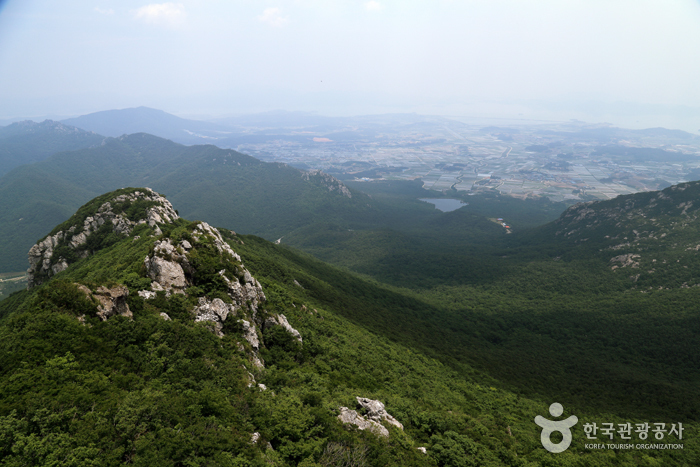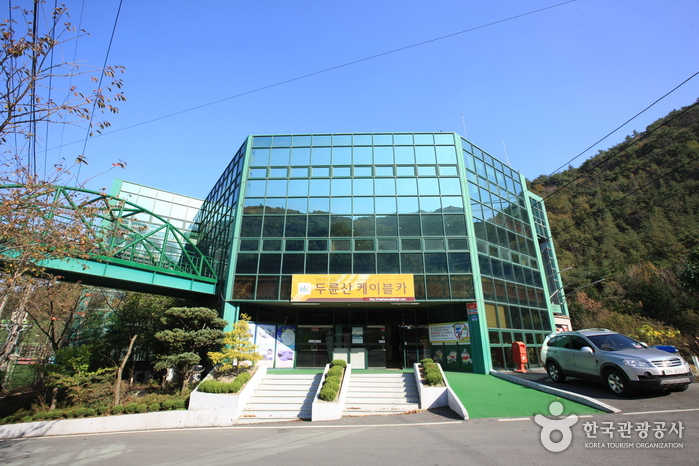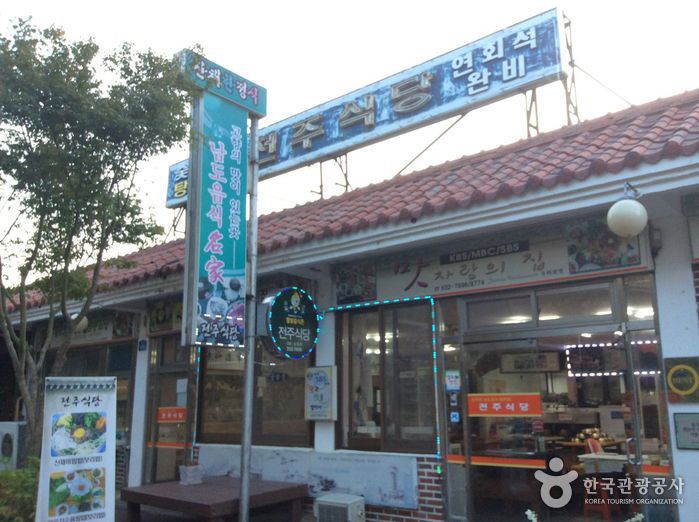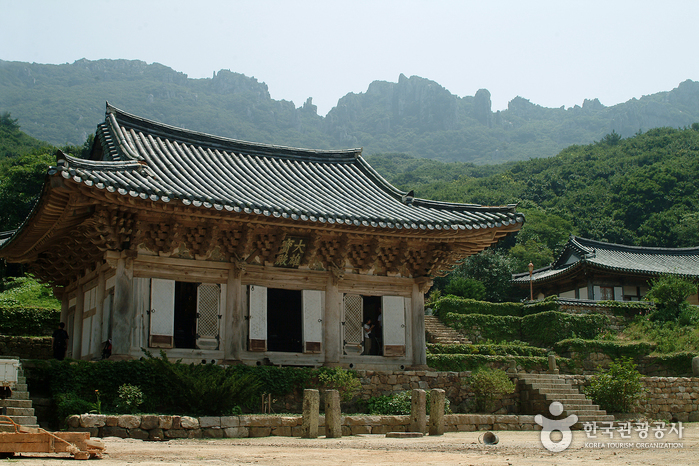Haemaru healingsoup [Korea Quality] / 해마루 힐링숲 [한국관광 품질인증]
0m 5747 2020-12-12
108-35, Donghae-gil Bukpyeong-myeon, Haenam-gun, Jeollanam-do
+82-10-2332-6303
'Haemaru Healing Forest is a guesthouse situated at the foot of Duryunsan Mountain, Haenam in front of Wondo Beach and surrounded by a cypress grove. The mountain, cypress grove, and beach are all visible from the main floored hall room. For this reason, many of the guests who stayed here say that the picturesque view seems to change day by day. The town where the guesthouse is located is specially designed as a 'hanok village,' consisting mostly of traditional Korean houses of Jeollanam-do. It is also widely known as 'Haenam Kimchi Village' because of their famous cabbages, which are grown in the natural environment and are used to make kimchi. Specifically, there are three villages in this area: 'Green Experience Village,' 'Farm Stay Village,' and 'Resort Village.' There is a public swimming pool in the area managed by the villagers and is very popular among visitors, with ticket sales reaching KRW 100,000,000 a year. One of the advantages of staying at this guesthouse is that it’s within a one-hour ride to a number of popular nature destinations such as Wando Cheongsando Island, Gangjin Dasan Chodang, Jangheung Cheongwansan Mountain, Woodland, and Yeongam Wolchunsan Mountain. Haenam is known as one of the best regions of Korea for enjoying the famous Jeolla-do cuisine, so visitors to Haenam are advised to try the local food. The villagers built these traditional Korean guesthouses so that their visitors can have a day of relaxation in nature, away from their hectic city life. With this mind, they used natural pinewood and red clay from Gangwon-do to build authentic traditional Korean houses and utilized traditional Korean tiles from Goryeong. The name 'Haemaru Healing Forest' was given by the owner of the guesthouse, with the subtitle 'A place where you can tell your story.' The guesthouse buildings are in 'ㄱ' shape. The main building, called 'anchae' in Korean, has floor area of 72m², which is big enough for up to 25 people. There are two rooms, a large living room, and a kitchen in this building. The rooms are furnished with sofa, television, air conditioner, refrigerator, and table just like an ordinary home so that guests can feel at home during their stay. The 'bakkatchae,' or 'detached house,' is a single room with capacity of 6 and is furnished with air conditioner and bathroom. The guesthouse is owned by a couple who still work in Seoul and need to travel back and forth between Seoul and Haenam frequently. They're both nature lovers, so their most favorite place in the house is the kitchen garden where they cultivate their own organic lettuce, perilla leaves, and chili peppers. The kitchen garden is open to guests who want to try the homegrown organic vegetables. Various experience programs are offered here as well, such as yunnori, dadeumi, jwibulnori, and kimchi making. Jwibulnori is a traditional Korean game played on the eve of Daeboreum or First Full Moon Day, where people burn dry grass on the ridges of rice paddies and fields and others spin cans of flames attached to the end of a stick or a sling. For safety reasons, this game is played with the consent and participation of the villagers, so be sure to ask the owner of the guesthouse when the game is played. It’s free for groups of more than 10 people. As for the kimchi-making class, it is offered by the guesthouse owner's younger brother and sister-in-law who live and run a kimchi factory in the village. They will teach you how to make kimchi, step-by-step, start to end. The kimchi-making class is a paid program, so be sure to ask the guesthouse owner how much and when the class is held.
Seoladawon [Korea Quality] / 설아다원 [한국관광 품질인증]
4.1 Km 10534 2023-10-26
153-21 , Samseong-gil, Haenam-gun, Jeollanam-do
+82-61-533-3083
Seola Dawon is a hanok stay at the foot of Mt Duryun in Haenam, Jeollanam-do. It began as a tea plantation whose owner wanted to pass on his love for traditional tea culture to the next generation. Many visitors came and they needed accomodation, so the owner built a small stone guest room. Now there are 8 guestrooms, including a clay house, a timber frame house, and an earthbag house; while the work of promoting tea cultivation and culture continue.
Daeheungsa Temple [UNESCO World Heritage] (대흥사[유네스코 세계문화유산])
4.7 Km 14934 2020-12-22
400, Daeheungsa-gil, Haenam-gun, Jeollanam-do
+82-61-534-5502
Daehuengsa Temple is told to have been built during the time of King Seong of the Baekje period by Adohwasang, a Silla Monk and the site was the restoration of Samjae bulipjicheo of Buddhist culture, which protects Samjae, the three disasters of one’s life.
Pyochungsa and Iljiam Tea Garden display writings and traces of the prominent men of the time such as Chusa Kim Jeong-hui and Chouiseonsa Buddhist monk. Inside the temple, Daeungbojeon, Chimgyeru, Myeongbujeon, Eungjindang, Cheonbuljeon, Cheonbulsang, Pyochungsa, Daegwangmyeongjeon, Iljiam, Bungmireugam, and Seongbo Museum are situated.
The Rock-carved Seated Buddha at North Mireugam Hermitage of Daeheungsa Temple, Haenam (National Treasure No. 308) and Bronze Bell with Inscription of Tapsansa Temple (Treasure No. 88) are preserved as well as various cultural assets and fables such as Budojeon, and Stupa Courtyard, the largest in Korea.
Duryunsan Provincial Park (두륜산도립공원)
6.0 Km 12644 2021-02-17
400, Daeheungsa-gil, Haenam-gun, Jeollanam-do
+82-61-530-5543
Containing many Buddhist temples and ruins as well as spectacular scenery, the 700 meter-tall Duryunsan Mountain is located at the southernmost point of the Korean peninsula. Forested by subtropical green broadleaf trees and temperate deciduous broadleaf trees, the mountain is valued highly for observing plant chorology. There are many fields of silver grass, and the summit of the park's eight peaks provide vistas of the western and southern sea.
During the fifth year of King Jinheung's reign (514), the Buddhist monk Ado built Daedunsa Temple, which is a place of great historical value as it is also related to the Buddhist monk Seosan. The temple is built among dense woodlands, consisting of maple trees and camellias. Breathtaking scenery of valleys and luxuriant trees can be seen on both sides of the 2-kilometer-long road leading to the temple.
Duryunsan Cable Car (두륜산케이블카)
6.7 Km 45352 2020-05-19
88-45, Daeheungsa-gil, Haenam-gun, Jeollanam-do
+82-61-534-8992
Duryunsan Mountain (700 meters) is a famous mountain in Jeollanam-do. With its eight peaks, it is home to many temples and historic sites. The mountain also holds great importance in plant chorology as its forests consist of warm-temperate broad-leaved evergreens and deciduous broad-leaved trees. The mountain peak can be reached by trekking for about 2-3 hours from the entrance of Daeheungsa Temple or by the Daeryunsan Cable Car (one way 8-minute), which departs from the entrance on the opposite side of the mountain and takes visitors to a spot right below the peak. From the mountain summit, there is a view of the southern sea and on a clear day, it is possible to see as far as Hallasan Mountain on Jeju Island. Nearby tourist attractions include Uhangri Dinosaur Museum Complex, Usuyeong Tourism Village and Ttangkkeut Village.
Jeonju Sikdang (전주식당)
6.7 Km 24728 2021-10-16
170, Daeheungsa-gil, Haenam-gun, Jeollanam-do
+82-61-532-7696
Jeonju Sikdang is a noted restaurant for Haenam folk cuisine. It was designated by the Korean Traditional Culture Preservation Society after
getting many awards, such as Special Culinary Award.
The main items on the menu are pyogo jeongol (shitake mushroom hot pot) and sanchae jeongsik (set menu with seasoned wild vegetables). In particular, the restaurant's signature pyogo jeongol uses ingredients that are all prepared in house using organic shitake mushrooms, beef, Manila clams, along with other seafood and vegetables, giving it a clean and rich taste. The theme of the restaurant, “Enjoying natural dishes in the mountains,” fits perfectly with the taste of their mushrooms, which carries a excellent taste without the addition of any artificial seasoning. The restaurant also sells dongdongju (traditional Korean liquor), a drink that brings deeper flavors of the food.
Sanmaruteo (산마루터)
6.7 Km 23180 2024-02-28
88-33 Daeheungsa-gil, Samsan-myeon, Haenam-gun, Jeollanam-do
Sanmaruteo is a specialty restaurant offering traditional healthy cuisine from the Namdo region of Korea. They exclusively serve a single menu: Cheonggukjang chalbap (Rich soybean paste soup and steamed sweet rice). Served with hot stone pot rice, cheonggukjang (rich soybean paste soup) and a variety of hearty side dishes. Freshly cooked rice in a hot stone pot that enhances the flavor. Alongside dishes like pan-fried bean curd, grilled yellow croaker, and spicy stir-fried pork, accompanied by various seasoned salad, visitors can enjoy a satisfying meal.
Mihwangsa Temple (미황사)
8.0 Km 18948 2021-08-14
164, Mihwangsa-gil, Haenam-gun, Jeollanam-do
+82-61-533-3521
Constructed during the eighth year of King Gyeongdeok of the Silla dynasty (749), Mihwangsa Temple is located on the western side of Dalmasan Mountain (489 meters), titled the Geumgangsan Mountain of the Southern Sea. The temple is situated the furthest south of all temples in the Korean peninsula. Beautiful sunsets and the view of the graceful Dalmasan Mountain from the temple attract numerous visitors. The foot of the mountain found behind the temple blends well with the suitable-sized temple and the appearance of Daeungbojeon Hall gives out an aura of comfort and tranquility. The cornerstone of Daeungbojeon Hall is carved with sea creatures, such as turtles and crabs that cannot be observed elsewhere. Other attractions include 18th century murals on the walls of Daeungbojeon and Unginjeon Halls.
Geomokjang Minbak Lodging [Korea Quality] / 거목장민박 [한국관광 품질인증]
8.3 Km 135 2023-10-26
63 , Minbakchon-gil, Haenam-gun, Jeollanam-do
+82-61-535-1456
Geomokjang Minbak (‘B&B’) stands at the foot of Mount Doryunsan, Hanam-gun, Jeollanam-do, and is part of Museon Hanok Minbak Village. The hanok’s pillars and rafters are built of old pinewood, and the wooden floors, windows and doors are lined with Korean paper. All 7 rooms have modern bathrooms. In the large tree-shaded yard you can experience bonsai making for a small fee, while beyond the low stone wall are fields and trees. Geomokjang is a good base for exploring Haenam and is on the way to Daeheungsa, a temple with a thousand years of history.
Wando Arboretum (완도수목원)
8.9 Km 37052 2021-04-02
156, Chopyeong 1-gil, Wando-gun, Jeollanam-do
+82-61-550-1544
Wando Arboretum features the largest and oldest broadleaf evergreen colony in the nation, along with over 3,800 other flora on a grand plot of land. The arboretum is comprised of an exhibition hall, greenhouses, walking paths, an observatory, campground, basketball court, and more.
Created in 1991, Wando Arboretum is the only warm temperate arboretum in Korea where only 15% of the landscape is considered a warm temperate region. The broadleaf evergreen tree forest has high medicinal value, and is home to many species of rare warm temperate plants such as goodyera, calanthe striata, and cephalanthera falcata. There are 30 special gardens based on different plant types. From the observatory, visitors can enjoy the view of Dadohaehaesang National Park and the southern sea. The observatory offers an opportunity to educate visitors on nature and the environment and allows them to take a rest during their visit.
![Haemaru healingsoup [Korea Quality] / 해마루 힐링숲 [한국관광 품질인증]](http://tong.visitkorea.or.kr/cms/resource/35/2049835_image2_1.jpg)
![Seoladawon [Korea Quality] / 설아다원 [한국관광 품질인증]](http://tong.visitkorea.or.kr/cms/resource/25/3021525_image2_1.jpg)
![Daeheungsa Temple [UNESCO World Heritage] (대흥사[유네스코 세계문화유산])](http://tong.visitkorea.or.kr/cms/resource/09/1929609_image2_1.jpg)





![Geomokjang Minbak Lodging [Korea Quality] / 거목장민박 [한국관광 품질인증]](http://tong.visitkorea.or.kr/cms/resource/63/3021963_image2_1.jpg)
 English
English
 한국어
한국어 日本語
日本語 中文(简体)
中文(简体) Deutsch
Deutsch Français
Français Español
Español Русский
Русский